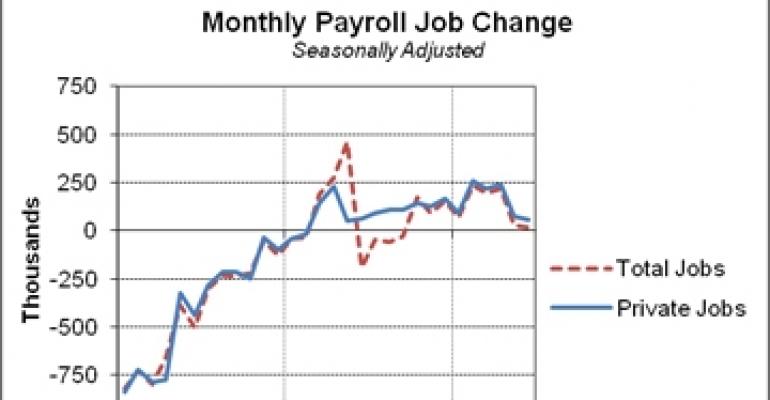To say that the June jobs report released by the U.S. Department of Labor last Friday fell short of expectations would be a gross understatement. After all, the consensus among economists heading into late last week was that the economy had added 125,000 nonfarm payroll jobs in June. The actual number, however, came in at 18,000.
Meanwhile, the national unemployment rate ticked up from 9.1% in May to 9.2% in June. Perhaps even more troubling is that the change in total nonfarm payroll employment for April was revised downward from a gain of 232,000 to 217,000. Likewise, the figure for May was lowered from a gain of 54,000 to 25,000.

“Watching CNBC, as I usually do on ‘Jobs Friday,’ was painful,” wrote Bob Bach, chief economist for brokerage firm Grubb & Ellis, in his Good News Friday report, the title of which sounded out of tune with the dismal data. “There were audible gasps from the assembled panel of economic luminaries when the 8:30 a.m. announcement from the Bureau of Labor Statistics revealed a shockingly low 18,000 net new payroll jobs created last month.”
Among the report’s highlights and lowlights:
• The gain of 57,000 jobs in the private sector was partially offset by a loss of 39,000 public sector jobs. Employment in both state and local government continued to trend down over the month and has been falling since the second half of 2008.
• Some of the sectors posting increases last month were leisure and hospitality (+34,000), professional and business services (+12,000) and retail trade (+5,200).
• Besides the government, other employment sectors posting losses included financial activities (-15,000) and construction (-9,000).
• The average hourly earnings of employees on private nonfarm payrolls fell from $23 in May to $22.99 in June, and average weekly hours dipped from 34.4 to 34.3.
While it was certainly a dismal jobs report on a broad-based level, Bach urged commercial real estate professionals to keep matters in perspective.
“Factory orders, exports and business capital spending appear to be holding up; energy prices are coming down; supply chain disruptions related to the disasters in Japan are being smoothed out; and the Federal Reserve’s monetary policy remains highly accommodative — all of which suggest that growth should firm up going forward,” wrote Bach.
The labor market is a lagging indicator, emphasized the veteran economist. “The softness in the past two months likely is somewhat of a delayed reaction to high energy prices earlier in the year.”
Research by economists Kenneth Rogoff of Harvard University and Carmen Reinhart of the Peterson Institute for International Economics shows that recessions triggered by a financial crisis are deeper, and the recoveries more protracted, than recessions brought on by other factors such as rising inflation and interest rates.
“The deleveraging process in the household and government sectors continues to weigh down the pace of improvement,” concluded Bach. “Expect the recovery to continue, but at a less-than-satisfying pace.”

